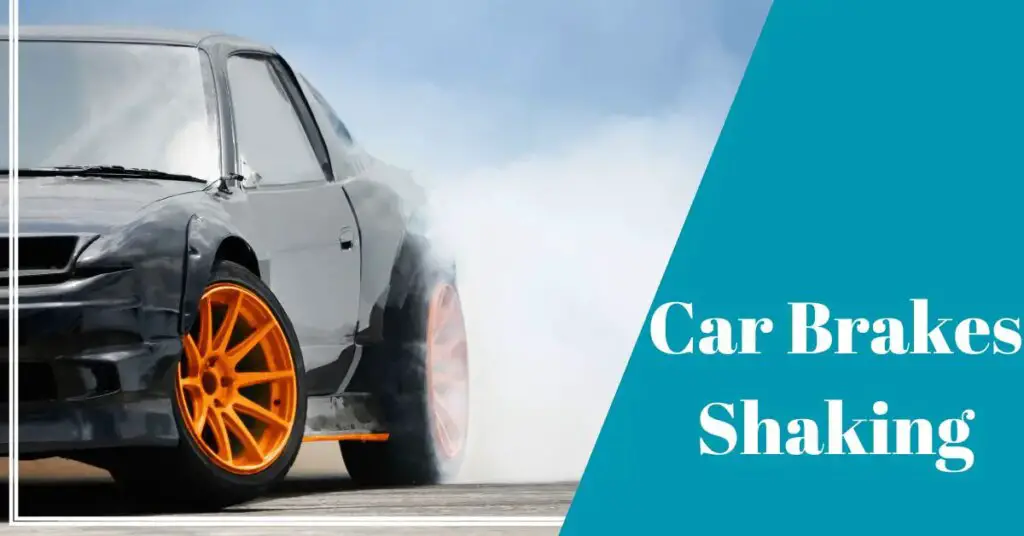When you’re driving down the road, your car’s brakes are one of the most critical safety components. So, imagine the alarm when you feel your car’s brakes shaking uncontrollably. This car brakes shaking phenomenon can be both unnerving and dangerous, leaving many drivers wondering what could be causing it and how to resolve the issue.
In this article, we’ll explore the various reasons behind car brakes shaking and offer valuable solutions to keep you safe on the road.
Table of Contents
Understanding Brake Systems
Before diving into details, I’d like to give you an insight into the brake system. Here is the brake system 101:
Basic Brake System Components
A brake system in a typical passenger vehicle comprises several components that work together to slow down or stop the vehicle. The main components include:
Brake Pads
Brake pads are essential components of the braking system. They are typically made of various friction materials, such as composite materials or metallic compounds, that can withstand high levels of heat and pressure generated during braking. When you press the brake pedal, the brake pads are forced against the spinning brake rotors, creating the friction that slows down or stops the vehicle.
Brake Rotors
Brake rotors are flat, heat-dissipating discs that attach to the wheel hubs. They are usually made of cast iron or composite materials and are designed to withstand the intense heat generated during braking. When the brake pads press against the rotors, the friction converts the moving vehicle’s kinetic energy into heat, which is then dissipated by the rotors, allowing the vehicle to slow down or stop.
Brake Calipers
Brake calipers are crucial for the operation of the brake system. They house the brake pads and contain pistons that push the pads against the brake rotors when the driver applies the brakes. The calipers play a significant role in controlling the pressure exerted on the brake pads, allowing for smooth and efficient braking.
Brake Fluid
Brake fluid is a specially formulated hydraulic fluid that transfers the force from the brake pedal to the brake calipers. It operates on the principle of Pascal’s law, which states that pressure exerted on a fluid in a confined space is transmitted uniformly in all directions. When you press the brake pedal, the brake fluid pressure increases, forcing the brake caliper pistons to push the brake pads against the brake rotors, resulting in the braking action.
How to Identify Shaking Brakes
Shaking or vibrating brakes can be an indication of various issues with the braking system. If you experience any of the following signs, it’s essential to address them promptly to ensure your safety and the proper functioning of your vehicle’s brakes:
Steering Wheel Vibrations

One of the most common signs of shaking brakes is when you feel vibrations through the steering wheel while braking. When you apply the brakes, the uneven contact between the brake pads and rotors can cause the steering wheel to shake or vibrate. This is often a sign that the brake rotors may be warped or unevenly worn.
Pedal Pulsation
Similar to steering wheel vibrations, you may feel pulsations or vibrations in the brake pedal when you apply the brakes. This pulsation occurs due to the uneven pressure distribution caused by warped brake rotors or other issues in the braking system.
Unusual Noises
Shaking brakes may also produce unusual noises during braking. When applying the brakes, you might hear grinding, squealing, or groaning sounds. These noises can indicate worn-out brake pads, lack of lubrication, or problems with the brake calipers.
Vehicle Veering to One Side
If your vehicle pulls or veers to one side when you brake, it can be a sign of a sticking brake caliper or uneven brake pad wear. A stuck caliper can cause uneven wheel braking force, leading to the veering effect.
Why Does Your Car Shake When Braking?
What are the causes of car brake shaking? You may ask. Here are some common causes for this matter:
#1 Worn Brake Pads
Brake pads are designed to create friction against the brake rotors when you apply the brakes. Over time, the friction material on the brake pads wears down due to repeated braking, resulting in thinner pads. If the pads wear too much, the metal backing plate might come into contact with the rotors, causing damage to both components.
How does it affect braking performance and cause shaking? Worn brake pads have reduced stopping power, which can lead to longer braking distances. Besides, uneven wear on the brake pads can cause uneven contact with the rotors, leading to vibrations and shaking during braking. The uneven contact creates variations in friction, resulting in the pulsating sensation felt through the brake pedal and steering wheel.
Here are the signs of worn-out brake pads:
-
- Squealing or grinding noises when applying the brakes.
- Reduced braking performance and longer stopping distances.
- Visual inspection showing thin brake pad thickness.
#2 Warped Brake Rotors
Brake rotors can become warped due to excessive heat and cooling during braking. The uneven heating and cooling cause the rotor’s metal to contract and expand unevenly, resulting in a warped surface. Warped rotors have an irregular contact patch with the brake pads, leading to shaking and vibrations during braking.
So, what are the reasons for rotor warping?
- Heavy braking for extended periods, such as driving down steep hills.
- Braking forcefully from high speeds frequently.
- Sudden cooling of hot brake rotors, such as driving through puddles after heavy braking.
If you experience any of the following symptoms, you may have warped brake rotors:
-
- Shaking or vibrations in the steering wheel and brake pedal during braking.
- Squealing or grinding noises when applying the brakes.
- Vehicle may pull to one side during braking.
Check out this video for how to identify warped rotors easily!
#3 Brake Caliper Issues
Brake calipers house the brake pads and are responsible for pushing them against the rotors during braking. Sometimes, calipers can stick or become seized, leading to uneven braking pressure and contact between the pads and rotors.
How do caliper problems lead to brake shaking, then? A stuck or seized caliper can cause uneven braking on one wheel, resulting in the vehicle pulling to one side during braking. The uneven brake pressure can also lead to uneven wear on the brake pads and rotors, causing vibrations and shaking.
Signs of faulty brake calipers:
- Uneven brake pad wear between wheels.
- Vehicle pulling to one side during braking.
- Excessive heat coming from one wheel after driving.
# 4 Uneven Tire Wear
You may wonder what the link between tire condition and braking performance is. Well, tires are essential for maintaining proper road contact and grip. Uneven tire wear can lead to an imbalance in braking performance, affecting the stability and smoothness of braking.
Unevenly worn tires can cause uneven road contact during braking. This imbalance can lead to irregular forces acting on the suspension and brake components, resulting in shaking or vibrations when braking.
Tips for checking tire condition:
-
- Regularly inspect tire tread depth and look for signs of uneven wear.
- Check tire pressure to ensure proper inflation.
- Rotate and balance tires as per the vehicle manufacturer’s recommendations.
# 5 Brake Fluid Problems

Brake fluid is crucial for transferring hydraulic pressure from the brake pedal to the calipers, ensuring efficient braking performance.
So, how do air bubbles or contamination affect braking? Air bubbles in the brake fluid can compress, leading to a spongy brake pedal and reduced braking performance. Contamination in the brake fluid can cause corrosion and damage to the brake system components, affecting braking efficiency.
Signs of brake fluid issues:
-
- Spongy brake pedal that sinks to the floor.
- Brake fluid leaks near wheels or brake components.
- Discolored or dirty brake fluid in the master cylinder reservoir.
#6 Suspension Problems
The suspension system plays a vital role in maintaining stability and road contact during braking. Issues with the suspension, such as worn-out components, misalignment, or broken parts, can lead to an imbalance in weight distribution during braking. This imbalance can cause shaking or vibrations.
Identifying suspension issues:
-
- Inspect the suspension components for signs of damage or wear.
- Check for unusual noises or clunks while driving over bumps.
- Have the suspension alignment checked by a professional if the vehicle pulls to one side during braking.
Why Does My Car Shake After Changing Brakes?
Experiencing shaking in your car after changing brakes can be due to several reasons:
- Bedding-In Process: After installing new brake pads, they need to go through a bedding-in process. During this process, the new brake pads need to establish proper contact with the brake rotors. Shaking or vibrations can occur temporarily during this initial phase but should diminish as the brake pads wear into the rotor’s surface.
- Rotor Resurfacing or Replacement: If the brake rotors were resurfaced or replaced along with the brake pads, they may need some time to settle in. Newly resurfaced or replaced rotors may exhibit slight imperfections or variations in surface smoothness, causing initial shaking until they wear into the brake pads evenly.
- Brake Pad Quality: The quality of the new brake pads can influence their performance. Low-quality or aftermarket brake pads may not fit as precisely or provide the same level of performance as original equipment manufacturer (OEM) brake pads, leading to vibrations during braking.
- Caliper Issues: If the brake calipers were not properly serviced or lubricated during the brake pad replacement, they may not apply even pressure on the new brake pads, causing shaking during braking.
- Rotor Runout: Rotor runout refers to excessive lateral movement of the brake rotor. If the rotor runout is not within the manufacturer’s specified tolerance, it can cause uneven contact with the brake pads and lead to shaking.
- Loose Components: Check for loose or improperly tightened components, such as wheel lug nuts or caliper bolts, as these can contribute to vibrations of brake system.
- Wheel Balance: Coincidentally, the car may experience unrelated wheel balance issues after the brake pad replacement, leading to vibrations while driving.
If the shaking persists or worsens, it is essential to have your vehicle inspected by a qualified mechanic to identify the specific cause and address any issues promptly.
How To Do DIY Brake Inspection
Performing a DIY brake inspection can help you identify potential issues with your vehicle’s braking system and ensure your safety on the road. Here’s a step-by-step guide to conducting a basic brake inspection:
Visual Inspection of Brake Pads and Rotors
Closely inspect the brake pads through the openings in the wheel rims or by removing the wheels if needed. Look for the thickness of the brake pads; they should have ample material left.
If the brake pads appear excessively worn (less than 1/8 inch or 3 mm of friction material remaining), consider replacing them.
Check the brake rotors for any visible damage, scoring, or warping signs. Warped rotors may have uneven wear patterns or a glazed appearance.
Checking Brake Fluid Levels and Condition
Locate the brake fluid reservoir under the hood. The reservoir is typically mounted on the master cylinder and is translucent, allowing you to see the fluid level easily.
Check the brake fluid level. It should be between the “MIN” and “MAX” marks on the reservoir. If it’s low, top it up with the recommended brake fluid.
Observe the color of the brake fluid. Fresh brake fluid is usually clear or slightly yellow. If the fluid appears dark or has visible contaminants, it may be time to flush and replace the brake fluid.
Assessing Tire Wear and Pressure
Inspect the tread wear on all four tires. Look for any uneven wear patterns, such as excessive wear on one side or the center of the tire.
Measure the tire tread depth using a tread depth gauge or a penny. Adequate tread depth is essential for proper braking performance, especially in wet conditions. Replace tires if they are worn beyond the recommended depth.
Check the tire pressure with a tire pressure gauge and ensure it matches the manufacturer’s recommended pressure. Properly inflated tires contribute to better braking and handling.
You can check out this video for detail!
Basic Suspension Check
Inspect the suspension components for any signs of damage, wear, or leakage.
When applying pressure to the vehicle’s body, check for any visible misalignment, sagging, or unusual movements.
If you notice any issues with the suspension, such as broken or worn-out components, consider having a professional mechanic inspect and repair it.
Test Drive
After completing the visual inspection, take your vehicle for a test drive. Pay attention to how the brakes feel and listen for any unusual noises during braking. If you experience any vibrations, pulling to one side, or other irregularities, it may indicate brake issues that require further inspection by a qualified mechanic.
Remember, while a DIY brake inspection can help you identify obvious problems, it’s essential to have your vehicle’s brakes professionally inspected and maintained regularly. A qualified mechanic can conduct a more comprehensive inspection and address any underlying issues to ensure your brakes are in optimal working condition and keep you safe on the road.
How To Fix Car Brakes Shaking
Let’s see what we can do to fix the car brakes shaking:
Replacing Brake Pads
Although replacing brake pads is a relatively DIY straightforward process, it requires some basic automotive knowledge. Here’s a general guide to help you with the process:
Materials Needed:
- New brake pads (matching the specifications of your vehicle)
- Jack and jack stands
- Lug wrench
- C-clamp or brake caliper tool
- Brake grease or anti-squeal compound
- Service manual or repair guide for your specific vehicle
Step-by-step instructions to replace brake pads:
- Park the vehicle on a level surface, engage the parking brake, and chock the wheels for safety.
- Loosen the wheels’ lug nuts where you’ll replace the brake pads, but do not remove them completely.
- Use the jack to lift the vehicle and secure it with jack stands.
- Remove the lug nuts and wheels to access the brake calipers and pads.
- Locate the brake caliper, which is usually held in place by bolts. Remove the bolts and carefully slide the caliper off the rotor.
- Take out the old brake pads from the caliper bracket. Note their positioning for proper installation of the new pads.
- If necessary, compress the brake caliper piston using a C-clamp or brake caliper tool to make room for the thicker new brake pads.
- Install the new brake pads in the same position as the old ones and reattach the caliper to the bracket.
- Tighten the caliper bolts to the manufacturer’s recommended torque specifications.
- Replace the wheels, tighten the lug nuts, and lower the vehicle to the ground.
- Pump the brake pedal a few times to ensure the caliper pistons adjust to the new pads’ position.
- Test the brakes in a safe area at low speeds before driving on the road.
Choosing the right brake pads for your car
When selecting new brake pads, consider factors like your vehicle’s make and model, driving style, and the type of brake pads that best suit your needs. There are three common types of brake pads: organic, semi-metallic, and ceramic. Each has its advantages and disadvantages in terms of performance, noise level, and longevity. Refer to your vehicle’s service manual or consult with a trusted automotive expert for guidance in choosing the appropriate brake pads.
Safety precautions and best practices:
- Always prioritize safety. Use proper jack points and secure the vehicle with jack stands before working underneath it.
- Avoid exposing brake components to dirt or grease, as it can affect braking performance.
- Follow the service manual or repair guide for your specific vehicle to ensure correct brake pad installation and torquing of caliper bolts.
Resurfacing or Replacing Rotors
When dealing with warped rotors, you have two primary options: resurfacing and replacement.
Pros and cons of resurfacing vs. replacement:
- Resurfacing (also known as machining or turning) involves removing a thin layer of material from the rotor’s surface to make it smooth and even again. This option is cost-effective but may not be suitable if the rotors are severely warped or thin.
- Replacement involves installing brand-new rotors, ensuring optimal braking performance and safety. Although more expensive than resurfacing, it is often recommended for severely warped or worn-out rotors.
Check out this video for how to resurface the brake rotor!
Addressing Brake Caliper Problems
If you suspect your calipers are sticking, you can try the following DIY methods to free them up:
- Gently tap the caliper with a rubber mallet to help release any corrosion or debris that might be causing the sticking.
- Apply a lubricant designed for brake components to the caliper slide pins and moving parts to improve their movement.
- Carefully retract the caliper piston with a C-clamp or caliper tool to ensure it moves smoothly.
When to replace calipers
If the caliper remains stuck or shows signs of damage or leakage, it’s best to replace it. Sticking calipers can lead to uneven brake wear and safety concerns.
Bleeding the brake system after caliper repair
Whenever you open the brake system (e.g., when replacing calipers), air may enter the system, causing a spongy brake pedal and reduced braking performance. It’s essential to bleed the brake system to remove any air bubbles and ensure proper brake function. Bleeding the brakes is a more involved process, and it’s recommended to follow the vehicle manufacturer’s specific bleeding procedure or seek the help of a professional mechanic.
Tips for Extending Brake Life and Preventing Issues
Only heroes can drive cars with brake problems. So what can we do to extend the brake life?
Brake System Flush
A brake system flush involves replacing the old brake fluid with fresh fluid to maintain the system’s efficiency and prevent issues. Over time, brake fluid absorbs moisture and becomes contaminated, leading to reduced braking performance and potential damage to brake components. Here’s why a brake system flush is crucial:
- Prevents Corrosion: Contaminated brake fluid can lead to corrosion inside the brake lines, calipers, and master cylinder. Flushing the system removes the old fluid and contaminants, reducing the risk of corrosion.
- Maintains Brake Performance: Fresh brake fluid has a higher boiling point, preventing brake fade during prolonged or heavy braking. It also ensures consistent brake pedal feel and responsiveness.
- Protects Brake Components: Clean brake fluid helps protect vital components like the master cylinder and ABS (Anti-lock Braking System) from damage, potentially saving on expensive repairs.
It is recommended to perform a brake system flush every 2 to 3 years.
Brake Pad Inspections and Replacements
Regular inspections and timely replacements of brake pads are essential for maintaining braking efficiency and extending brake life. Here’s why it’s crucial:

- Avoids Rotor Damage: Worn-out brake pads can damage the brake rotors, leading to costly rotor replacements or resurfacing. Replacing brake pads in a timely manner helps preserve the integrity of the rotors.
- Prevents Unsafe Braking: As brake pads wear down, the braking distance increases, reducing your ability to stop quickly in emergency situations. Replacing brake pads before they wear too thin ensures optimal braking performance and safety.
- Saves Money: Timely replacement of brake pads prevents further damage to the braking system, potentially saving you money on more extensive repairs.
- Noise Reduction: New brake pads help reduce brake noise, such as squealing or grinding, which can be annoying and may indicate brake issues.
Generally, brake pads should be replaced when they have around 1/8 inch (3 mm) of friction material left.
Tire Rotation and Alignment
Proper tire rotation and alignment not only extend tire life but also contribute to better brake performance. Here’s why these practices are important:
- Even Tire Wear: Regular tire rotations ensure that tires wear evenly, promoting consistent road contact and improving braking stability.
- Optimal Braking: Proper tire alignment ensures that all tires are aligned with the vehicle’s direction, reducing uneven forces acting on the braking system and promoting smooth, stable braking.
- Handling and Safety: Well-aligned tires and evenly worn treads contribute to better vehicle handling and safety, especially during braking and cornering maneuvers.
- Brake Component Protection: By reducing unnecessary stress on the brakes due to misaligned tires, proper alignment helps prevent premature wear on brake components.
What to Do if Your Car Shakes While Driving
1. Stay Calm: In an emergency situation, it’s natural to feel a surge of adrenaline and panic. However, try to stay as calm as possible. Take a deep breath and focus on the actions you need to take.
2. Firmly Apply the Brakes: Immediately press the brake pedal with firm and steady pressure. In a situation where brake shaking is occurring, keep consistent pressure on the pedal to maintain control over the vehicle. Avoid pumping the brakes, as modern vehicles with anti-lock braking systems (ABS) are designed to prevent wheel lock-up during emergency braking.
3. Steer Straight: Keep the steering wheel straight while braking. Avoid sudden or aggressive steering maneuvers, as they can lead to loss of control, especially in high-speed emergency braking situations.
4. Avoid Distractions: In an emergency, it’s crucial to stay focused on the road and your surroundings. Avoid distractions like using your phone, adjusting the radio, or turning to talk to passengers.
5. Look for an Escape Route: Assess the situation and look for a safe escape route, such as an empty lane or a clear area on the roadside, if available. However, do not make sudden lane changes unless you are certain it is safe to do so.
6. Signal Your Intentions: If you need to change lanes or make any sudden maneuvers, use your turn signals to alert other drivers of your intentions.
7. Regulate Braking Intensity: If you experience brake shaking or vibrations during emergency braking, try to regulate the braking intensity by easing off the brake pedal slightly. This can help reduce the shaking and allow the ABS to work effectively.
8. Be Mindful of Following Distance: In heavy traffic, maintain a safe following distance from the vehicle in front of you. This allows you to have enough time to react to sudden stops or emergencies.

9. Communicate with Others: Use your horn or headlights, if necessary, to communicate your presence to other drivers in the vicinity.
10. Assess After Braking: After the emergency braking situation, carefully assess the condition of your vehicle and surroundings before proceeding. If there are any issues with the brakes or the vehicle, pull over to a safe location and seek assistance.
Frequently Asked Questions
1. What causes my car’s brakes to shake when I slow down?
Brake shaking when slowing down is often caused by warped brake rotors. Warping can occur due to excessive heat during braking, uneven tightening of wheel lug nuts, or prolonged heavy braking.
2. Can I continue driving with shaking brakes?
It is not recommended to continue driving with shaking brakes as it may indicate underlying issues with the braking system. Shaking brakes can compromise braking performance, reduce control, and pose a safety risk. Have your brakes inspected and repaired by a qualified mechanic promptly.
3. How much does it cost to fix shaking brakes?
The cost to fix shaking brakes depends on the specific issue and the extent of the damage. It can range from relatively inexpensive tasks like brake pad replacement to more expensive repairs, such as rotor resurfacing or replacement. Get a detailed estimate from a trusted mechanic for accurate pricing.
4. Are there any DIY methods to fix warped rotors?
There are no effective DIY methods to fix warped rotors. Warped rotors usually require professional resurfacing or replacement. Attempting DIY methods may not resolve the issue and could lead to further damage.
5. What are the signs of worn-out brake pads?
Signs of worn-out brake pads include squealing or grinding noises during braking, reduced braking performance, and visible thinning of the brake pad material.
6. How often should I check my brake fluid?
It is advisable to check your brake fluid at least once a year or as recommended in your vehicle’s owner’s manual. Regular brake fluid checks ensure the proper functioning of the braking system.
7. Can unbalanced tires cause brake shaking?
Yes, unbalanced tires can cause brake shaking. Tire imbalance can create vibrations that affect the entire vehicle, including the braking system.
8. Is it safe to drive in the rain with shaking brakes?
It is generally safer to avoid driving in the rain with shaking brakes as wet conditions can increase stopping distances. Address the brake issue before driving in adverse weather.
9. What should I do if my car veers to one side during braking?
If your car veers to one side during braking, it could indicate uneven brake pad wear, caliper issues, or a problem with the brake lines. Have your vehicle inspected by a mechanic to diagnose and rectify the problem.
10. How long do brake pads typically last?
Brake pads typically last between 30,000 and 70,000 miles, depending on driving habits, road conditions, and the type of brake pads used.
11. What’s the role of ABS in brake shaking?
The role of ABS (Anti-lock Braking System) in brake shaking is to prevent wheel lock-up during emergency braking. The system modulates brake pressure rapidly to allow the wheels to maintain traction with the road, reducing shaking or skidding.
12. Can I drive downhill with shaking brakes?
It is unsafe to drive downhill with shaking brakes as it can lead to loss of control and overheating the braking system. Address the brake issue before driving downhill.
13. How can I tell if my calipers are sticking?
Signs of sticking calipers include uneven brake pad wear, the vehicle pulling to one side during braking, and excessive heat coming from one wheel after driving.
14. Will using high-performance brake pads reduce shaking?
High-performance brake pads may reduce shaking due to their improved materials and design. However, if other factors like warped rotors cause shaking, high-performance pads may not completely eliminate the issue.
15. Can a misaligned suspension cause brake problems?
Yes, a misaligned suspension can cause uneven forces on the braking system, leading to shaking or vibrations during braking.
16. How do I differentiate between normal and abnormal brake noises?
Normal brake noises include some squealing during light braking or slight grinding when using new brake pads. Abnormal noises include loud grinding, metal-on-metal sounds, or continuous squealing during braking, indicating potential issues with the brakes.
17. Can I use water instead of brake fluid in an emergency?
Using water instead of brake fluid in an emergency is not recommended. Brake fluid is essential for transmitting hydraulic pressure, and water cannot perform the same function, leading to brake failure.
18. Can both front and rear brake pads be replaced simultaneously?
It is not necessary to replace both front and rear brake pads simultaneously unless both sets are significantly worn out. However, it is essential to maintain balanced braking performance by replacing brake pads on the same axle at the same time when needed.
Conclusion
Experiencing shaking brakes while driving can be a nerve-wracking experience. Understanding the potential causes, identifying the underlying issues, and taking the necessary steps to resolve the problem promptly is essential. Regular brake maintenance, safe driving habits, and timely repairs can help keep your car’s braking system in top condition, ensuring your safety on the road.
Further Reading:
Hi there! I’m Naomi O’Colman. I’ve got years of experience working at an auto repair shop here in Texas under my belt. On top of that, ever since I was a kid I’ve been passionate about the auto industry. Since I’ve joined the team at automotivegearz.com I’ve been enthusiastically sharing my passion and insights with my readers. I’m dedicated to delivering high quality content and helping you stay up to date with the latest automotive trends and products out there!







